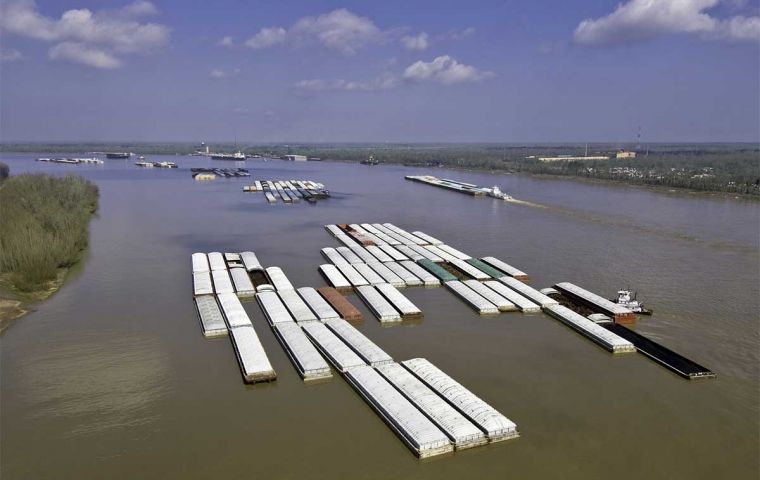MercoPress. South Atlantic News Agency
US grain exports threatened by insufficient draft along the Mississippi for barges
 Barges along the Mississippi must travel to ports carrying less grain because of insufficient draft
Barges along the Mississippi must travel to ports carrying less grain because of insufficient draft As has happened with the mighty Paraná River in the heartland of South America, with the Amazon in northern South America, and even with the Panama Canal, all of them suffering lack of rainfall to keep basins flowing with sufficient water levels, now has come the turn of the Mississippi with insufficient draft for the vessels and barges involved in transporting US grains.
“As we move into December – when precipitation occurs mostly in the form of snow – it is unlikely that water levels will fully recover,” said Susan Stroud, a grain analyst at No Bull.
This is only the latest threat to the competitiveness of American soy and corn compared to shipments from Brazil, where, at the moment, crops are amid the sowing season and do not face much competition.
After a sweltering summer between June and early September, the water level of this critical American waterway dropped to a record low of 12.04 feet (3.67 meters) below the baseline level in mid-October near Memphis. However, it experienced a mild recovery that aided grain exports.
However, the prospect of new water level declines, mean further setbacks for American farmers who must struggle with higher logistics costs than those in Brazil and Argentina. Pending sales for delivery in the current season are among the lowest in the last decade.
“When we have higher transport costs, they are passed on, pushing international buyers to search for cheaper bushels elsewhere,” said Stroud.
Conditions are unlikely to improve in the coming months, when the US typically benefits from reduced competition until the next Brazilian crop season begins.
According to the American Commercial Baggage Line, barges heading to southern US ports are carrying up to 600 tons less grain per vessel to avoid grounding. Last week, the operator suffered a loss equivalent to 14.6 boats due to delays.
Meanwhile, the number of ships awaiting at southern US ports to load grains in the next ten days has dropped to the lowest level since at least 2012 for this time of year, according to the US Department of Agriculture.
The situation is exacerbated by the fact that the Panama Canal, a crucial shortcut between the Atlantic and Pacific Oceans, is also experiencing historically low levels along the waterway.




Top Comments
Disclaimer & comment rulesCommenting for this story is now closed.
If you have a Facebook account, become a fan and comment on our Facebook Page!